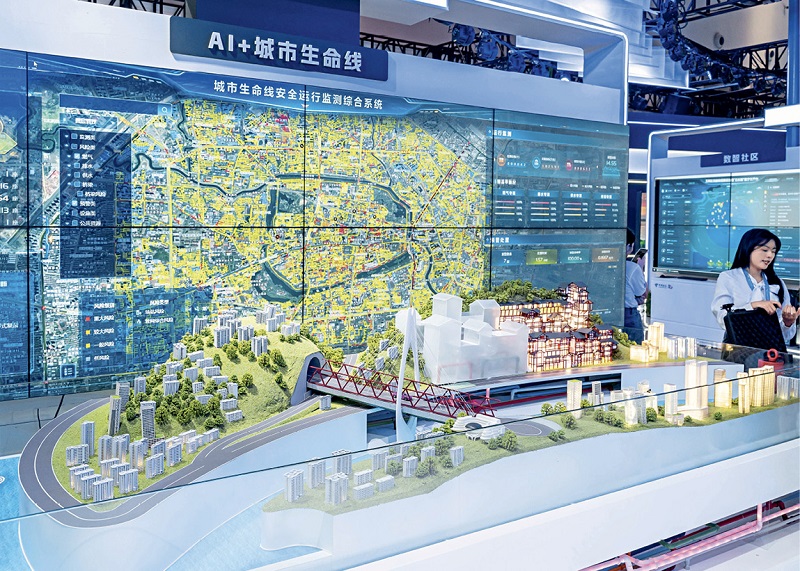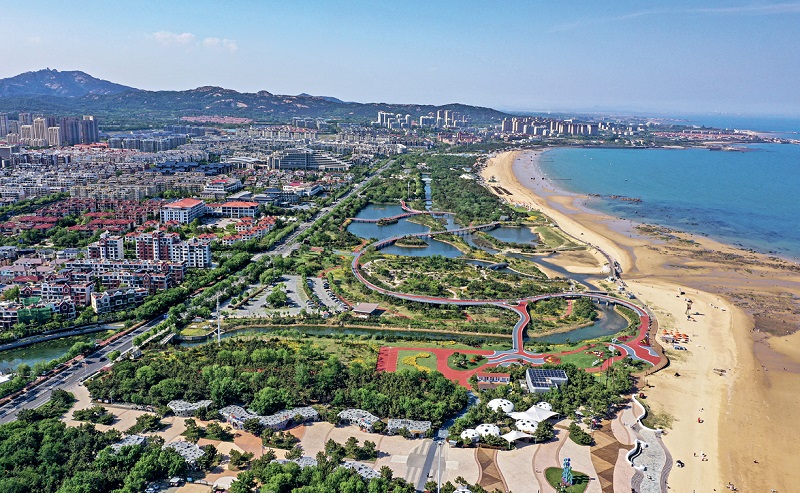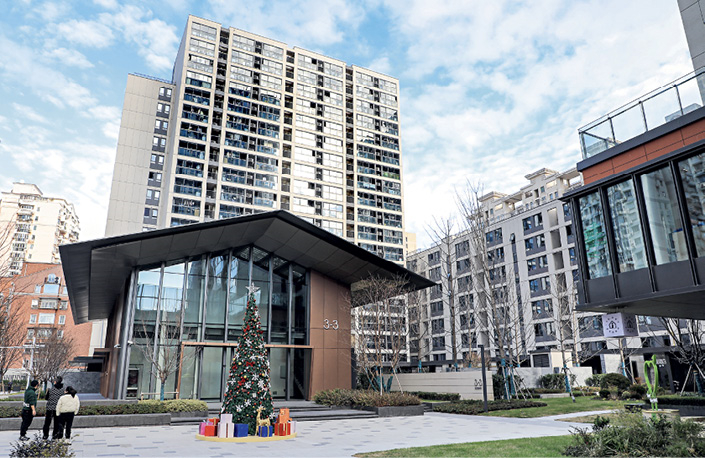President Xi Jinping’s recent domestic inspection tours emphasize a people-centered urban development path.
By the end of 2023, China’s urbanization rate had reached 66.16 percent, bringing with it opportunities as well as challenges in regard to improving the people’s lives. Chinese President Xi Jinping reiterated during his recent inspection trips to Shandong Province, Chongqing Municipality, and Shanghai Municipality the principle of people-centered development amid the pursuit of urban construction.

The model of an integrated monitoring system for the safe operation of urban lifelines using AI and big data displayed at the Smart China Expo in Chong-qing on September 6, 2023.
.png) Ecological Protection
Ecological ProtectionThe small coastal city of Rizhao in east China’s Shandong Province is bordered by a greenway that extends along its coastline. Beside the greenway is a wetland park where local residents come to stroll and cycle beneath flocks of seagulls flying overhead. Just a few years ago, the 28-kilometer Sunshine Coast Greenway was a shabby, unprepossessing area of saline-alkali soil spotted with aquaculture ponds. Since then, the local government’s ecological restoration project to develop the Sunshine Coast Greenway has transformed it into a highly desirable leisure and tourism site.
President Xi Jinping inspected the greenway on May 22, 2024, during his tour of Shandong Province. After a briefing on its construction and development, Xi directed his attention to a board showing how the greenway looked before and after its facelift. He commented that the greenway construction’s skillful combination of natural scenery and man-made facilities meets the needs of citizens and wins their hearts.”
Ecologically vulnerable areas along the route, such as abandoned shrimp ponds and wasteland, were the key focus of restoration and enhancement efforts during the construction of the greenway. Restoration of over 5,000 meters of coastline and the planting of 35,000 trees and 210,000 shrubs have effectively preserved the integrity and character of the coastal ecosystem.
The Sunshine Coast Greenway is now a major site for jogging, cycling, and various sports competitions. Statistics show that the 90 or more provincial and higher-level competitions that were held there in 2023 contributed considerably to local tourism development.
Ecological conservation has carried top priority in Rizhao’s urban development in recent years. Another example is the ecological restoration project of Rizhao Port in Hailong Bay. The first of its kind in China, the project has fostered a green and sustainable marine ecological environment by removing bulk cargo and coal operations from the urban areas. Upon its completion in 2019, the project had restored 1,882 meters of ecological shoreline and created 460,000 square meters of new beach area.
A better environment is guaranteed to attract more tourism, and Rizhao is indeed rapidly becoming one of the country’s most popular tourist destinations. The 53 million domestic tourists it welcomed last year chalked up a year-on-year increase of 66.5 percent, generating a tourism income of more than RMB 35 billion.
Rizhao’s success testifies to the crucial importance placed on ecological protection in urban development. Xi Jinping said at the 2015 Central Urban Work Conference that urban work should make creating a sound living environment its central goal. Integrating cities into nature so that urban dwellers may enjoy natural scenery also recalls their rural origins. In 2020, in his address to a grand gathering in celebration of the 30th anniversary of the development and opening-up of Shanghai’s Pudong, Xi Jinping said, “To create a harmonious and beautiful ecological environment, we should build cities into beautiful homes where people coexist in harmony with each other and with nature.”
Many other places in China are committed to protecting the environment while promoting urban development. To encourage local endeavors, China has, for instance, rolled out the initiative of national garden cities and forest cities. Between 2012 and 2021, green coverage of built-up urban areas increased from 39 percent to 42 percent, and the per capita area of park greenery from 11.8 square meters to 14.78 square meters. The dramatically enhanced living environment has immeasurably improved the quality of people’s lives.

The beautiful Sunshine Coast Greenway extending along the coastline of Rizhao City of east China’s Shandong Province.
Digital Empowerment
The burgeoning of such digital technologies as artificial intelligence has prompted their use in megacities like Chongqing Municipality in southwest China, which in recent years has prioritized digitalization to streamline its urban governance and development.
In April 2023, the megacity launched a comprehensive digital transformation initiative. Known as “Digital Chongqing,” it includes the establishment of an integrated intelligent public data platform, a three-tier digital urban operation and governance center, six major application systems covering different aspects of digitalization in Party building, governance, economy, society, culture, and the rule of law, and an intelligent governance framework.
President Xi Jinping visited the digital urban operation and governance center in Chongqing on April 23, 2024, during his inspection tour there. While at the center, Xi Jinping observed that “the modernization of governance system and capacity is an integral part of Chinese modernization,” adding, “to strengthen digital empowerment and promote the modernization of urban governance, it is necessary to scientifically plan and build big data platforms and network systems, strengthen joint command and coordination among all parties concerned, and effectively improve execution capacity.”
Serving as the brain of the city, the three-tier digital urban operation and governance center connects centers at the municipal, district/county, and town/sub-district levels, and gathers information on water resources, electricity, bridges, and tunnels, among others, to create a unified city operation index system. It provides the city’s monitoring and warning, command and dispatch, decision support, and event follow-ups, with end-to-end management, so improving urban governance capabilities.
President Xi Jinping noted, “Urban governance involves many aspects. The first is to have a strong sense of responsibility to make plans in advance, render management and control accurate and targeted, ensure rapid response, and effectively deal with all kinds of conditions, so as to ensure safe and orderly operation of the city.”
China’s largest city by size and population, Chongqing sits amid an area of mountains and hills. The consequences of natural disasters, fires, and other emergencies, therefore, are catastrophic. However, the center’s applications include an early warning and response to emergencies, consisting of 65,000-odd monitoring devices covering some12,000 geological hazard points, which notify and enable the relevant government departments to join forces at the center in an effective response to any emergency that may occur.
According to Chongqing Daily reports, in regard to the construction of governance centers at the district/county level, the platform of basic services covering all districts and counties in the city is now fully operational. Of the 123,000 tasks it has accepted, 101,000 have been settled—a settlement rate of 84 percent. Meanwhile, governance centers at the town/sub-district level, which gather geographic information from 11,200 villages and communities, now cover all the city’s primary levels.
President Xi commended Chongqing’s efforts on April 24, 2024, after listening to the work report of the CPC Chongqing Municipal Committee and Chongqing municipal government, saying, “It is important for Chongqing to speed up the development of a smart city, build a smart center for city operation and governance, and also establish and improve the ‘comprehensive and integrated’ city governance system and mechanism, so as to make city governance smarter, more efficient, and more targeted.”

Jingwan Apartment, the first community-based affordable housing for rent project in Huangpu District of Shanghai on January 16, 2024.
People’s City
Be it ecological protection or digital empowerment, a city’s development should always revolve around its people. President Xi Jinping proposed during an inspection tour of Shanghai in November 2019 the concept whereby “a people’s city is built by the people and for the people.” Xi endorsed this sentiment in his report to the 20th National Congress of the Communist Party of China in 2022, when he said, “Guided by the principle that cities should be built by the people and for the people, we will improve urban planning, construction, and governance.”
High rent is the concern of many people working in metropolitan areas like Shanghai. To solve the problem, Shanghai has made concerted efforts to build affordable rental housing, and provide housing support for new residents, young people, and frontline workers. As of March 31, 2024, the city had built and planned 491,000 affordable homes of various types, 304,000 of which are now occupied.
President Xi visited one such housing project in a residential community under the New Era Home for Urban Builders and Managers program in Minhang District of Shanghai in November 2023. Catering for frontline workers, including sanitation engineers and deliverymen, it has 138 rooms, each with a 35 square meter area, and 440 beds. The rent per bed in a four-person room is RMB 500 per month, and that in the two-person rooms is RMB 900 per month.
Residents at the community told President Xi, “The rent here is affordable, the bathroom has hot water that’s available 24 hours a day, and getting to work takes only about ten minutes. We are very satisfied.” There is a shared kitchen, laundry room, bathroom, and reception room here. Outside are badminton and basketball courts. “It’s very nice!” they enthused.
Xi expressed pleasure at seeing city builders from across the country living and working here in peace and satisfaction. He told them, “Socialism with Chinese characteristics is about achieving common prosperity. Migrant workers who come to make contributions to Shanghai are also masters of the city.”
He stressed, “It is essential to act on the principle that a city should be built by the people and for the people, continuously meet people’s diverse and varied housing needs, and ensure that migrant workers can come to stay here, live a secure life, and have their own careers.”
Cities across China are making strides in improving people’s lives. These include 15-minute urban community life circles, e-government services, and the renovation of old urban residential communities, among others. These are vivid embodiments of building a people-centered city, thus echoing President Xi’s words during his Shanghai trip, “A city should not only have high-rise buildings, but must also show sufficient concern for how people can lead a better life.”